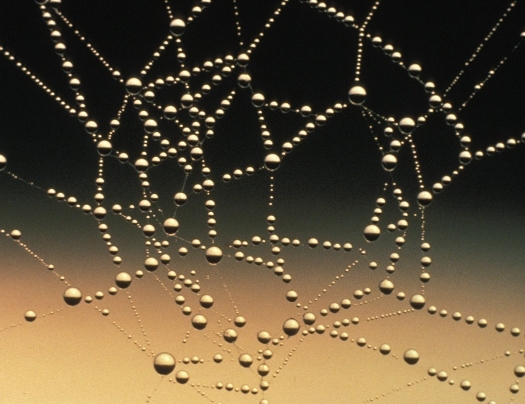Taking a walk to the store is a simple task, but it's one of the most challenging activities to describe if you are a physicist. The problem is that you have to walk through space to get to the store! Schoolchildren can describe space as "three-dimensional," but what is it? This simple question seems to be the very last holdout for completing a deep understanding of the physical world.
We draw lines on a piece of paper to represent the paths of particles. For physicists, only the points making up the patterns of lines are real like the cheese in Swiss cheese. We show crossing points between lines in space and time to represent events and interactions in a particle's history. (Physicists call these "worldlines.") Einstein says these points connected by worldlines are the only elements of the physical world that exist. All the other coordinate points on your piece of paper are unoccupied and empty. They neither exist nor have any influence on matter, just as the holes in Swiss cheese do not affect its flavor! You cannot see these empty points we call space, because no light or particles of matter are produced by them for our senses to interact with.
If you imagine a spider's web, it's easy to see what Einstein was talking about. It is only the web that defines the spider web, just as it is only worldline patterns that define where physical things exist and the geometry of space and time (called "spacetime"). All of our movement, all that we see, all interactions that we experience exist within this webwork of spacetime. The gaps between the worldlines mean nothing!
The illusion that space exists is a very stubborn one to eliminate. Einstein warned us that space and time are "modes in which we think, not conditions in which we exist." There is nothing other than the geometry of worldlines to describe spacetime. The background "thing" upon which we draw our worldlines and call "space" has no physical meaning at all. It is just the convenient mathematical scaffolding we use when we set up our physics problems to make calculations. Unfortunately, this scaffolding "tool" deceives us into thinking the gaps between the worldlines are also real and form a continuous surface or fabric whose geometry we can figure out.
Separating the tool from a description of the thing itself is especially hard when we try to think about corners of the world hidden from our senses and then ask what is going on there. For over 400 years physicists have used mathematical models to serve as our eyes for seeing things beyond our direct experience. Sometimes the difference is slight. You can see with your eyes that the path of a swinging pendulum is a perfect arc of a circle like the equations say, but elliptical orbits for planets have never been "seen," nor have electrons! When physicists explore events that are very small or very large, they place a lot of trust in what the mathematical models say, but they have to interpret them very carefully.
In the 1950s, Nobel laureate Richard Feynman created "Feynman diagrams" to allow physicists to organize mathematical quantities in the right order so that complex calculations could be carried out. They were like the schematic diagrams used by engineers to build a radio or a computer. Feynman said his diagrams were never intended to be a snapshot of what particles were actually doing. They were just a helpful mathematical tool and nothing more: scratch paper. But when you look at such a diagram, it is almost impossible not to think of it as some kind of photograph of what is actually happening as particles interact across space and time.
The entire story of our exploration of space revolves around the many different mathematical tools created to understand the basic data we have about it, such as its dimensionality or shape. This leads to a big problem: We can't seem to stop mistaking the tool for a description of space itself. Our descriptions increasingly look more like the scratch paper used to carry out a calculation. The tools make it seem as though space is physically real.
Like Feynman diagrams, the "macaroni diagrams" of string theory are very visually compelling. But the whole framework of string theory relies on there already being a preexisting spacetime in which these strings can move. The hope is that some version of string theory will do away with this background dependency. The new theory would create spacetime from out of the bowels of the string interactions themselves.
Loop quantum gravity, unlike string theory, is already background-independent. There is nothing needed "below" these quantum loops to create spacetime. As the loops knot themselves into elaborate patterns, spacetime emerges. There are no hidden dimensions to the world to worry about, but there is also no place for matter either. It is a world of pure spacetime with no stars, planets, etc.!
Whether you work in the string camp or the loop camp, you have in your mind's eye a vision of what spacetime looks like in terms of these mathematical constructs. Unlike planetary orbits, however, we have no independent way to "photograph" the elementary constituents to spacetime to confirm that they really are stringy or loopy! That also means we can never get closer to understanding what space is than its image reflected within the tools we use. This is what Einstein warned us about when he said that the idea of space is a mode in which we think but isn't real.
So what is it that we are doing when we walk to the store?
Think of a coral fan expanding into the "nothingness" of an ocean. The polyps create the tips of the coral tendrils, which grow into the abyss, forming a structure inch by inch. Our worldlines are like coral tendrils flowing into the future!
